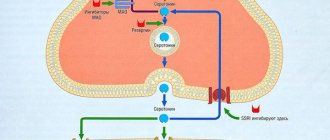What is anxiety?
Very often anxiety is confused with fear, but anxiety and fear are two different states, although they are inseparable from each other. Fear differs from anxiety in that there is always an object that causes this feeling, which can be met, seen, overcome.
With anxiety it's different. Often it exists on its own, without apparent reason. If anxious thoughts occur infrequently, and you can cope with them, then this is natural. However, if you don’t know how to get rid of the anxiety that constantly keeps you in suspense, you need the help of a specialist - there are signs of an incipient mental disorder.
How anxiety manifests itself - the main symptoms
Everyone is different, and anxiety is different for everyone - it can have emotional, psychological or physical symptoms. It has been noticed that the anxiety in the soul from the manifestation of physical symptoms only intensifies.
Psychological and emotional symptoms include:
- sleep disorders;
- excitement in anticipation of future events; it seems that all troubles, troubles, disasters are directed against you;
- inability to concentrate and concentrate due to unreasonable anxiety;
- constant feeling of anxiety and bad premonitions;
- groundless obsessive fears, even if their inconsistency is clear;
- irritability and increased nervousness;
- panic attacks and depression.
Physical symptoms of anxiety may include:
- loss of appetite;
- weaknesses;
- dizziness;
- headache;
- vomiting;
- frequent urge to urinate;
- increased sweating;
- unknown pain in the chest;
- weakening of sexual feelings;
- breathing disorders;
- muscle spasms and muscle pain.
Anxiety and Anxiety Disorders
16.05.2019
Psychologist's advice
Marusyak Olga Ivanovna
Anxiety disorders are by far the most common of the officially classified mental illnesses, especially in developed countries: in the United States, Europe, even ahead of depression and other mood disorders. It is unlikely that anyone today would argue with the fact that chronic stress is a distinctive feature of our era and that anxiety has become a kind of cultural phenomenon of our time. According to some modern researchers, we live in an era of anxiety. Anxiety is based on a person’s perception of the surrounding reality as unstable, unpredictable and threatening.
Interestingly, in the first half of the 20th century, anxiety simply did not exist as a clinical category. In 1950, psychoanalyst Rollo May noted in his book “The Meaning of Anxiety” that by that time only two thinkers had considered it necessary to write a separate work on anxiety: Søren Kierkegaard and Sigmund Freud.
Freud called anxiety “a mystery, the solution of which should throw light on our entire mental life.” By unraveling the mystery of anxiety, he believed, we would take a huge step toward penetrating the mysteries of the mind—consciousness, ego, personality, intellect, imagination, creativity, not to mention pain, suffering, hope, and regret. To understand anxiety is, in a certain sense, to understand human nature as such.
Nowadays, thousands of scientific papers are written about anxiety every year, and several specialized scientific journals are entirely devoted to it. Anxiety researchers are constantly making new discoveries concerning, in addition to the causes and methods of treating anxiety itself, the principles of the functioning of consciousness in general, the relationships between body and mind, genes and behavior, molecules and emotions. Functional magnetic resonance imaging (fMRI) has made it possible to associate subjective emotions with specific areas of the brain and even distinguish different types of anxiety based on the observed manifestations of brain activity.
Anxiety can be considered simultaneously as a phenomenon of biology and philosophy, body and spirit, instinct and reason, personality and culture. Anxiety, experienced as a sensation on a spiritual and psychological level, is amenable to scientific measurements at the molecular and physiological level. It is generated by both heredity and environment. This is both a psychological phenomenon and a sociological one. With all the richness and diversity of cultural characteristics, one cannot help but note the deep commonality of experiences at different times among different peoples, which speaks of the universality of anxiety as a property of human nature.
It is important to distinguish between the concepts of fear and anxiety. Fear is an unpleasant feeling caused by the feeling of danger, threat, or likelihood of causing pain coming from someone or something. Anxiety is a feeling of restlessness, nervousness and discomfort, usually in relation to an event or phenomenon with an uncertain outcome. If fear has a specific object, then anxiety has nothing like it.
Anxiety can be regarded as a normal reaction to a stressful situation because it helps to cope with it. If the anxious state is due to some external reasons, for example, if we are talking about concern for the health and well-being of a loved one who may be in danger, then researchers tend to consider such anxiety normal. However, over time, it can intensify and paralyze, and even disrupt the course of a person’s life, in which case anxiety is recognized as pathological. If anxiety becomes constant, then we can talk about an anxiety disorder. Almost all of us experience anxiety at some point in our lives, as it is a common reaction to real-life events, but not everyone develops long-term problems associated with anxiety.
Freud was the first to distinguish between “normal anxiety” (anxiety about a real threat can be productive) and “neurotic anxiety” (caused by unresolved sexual problems or internal mental conflicts, pathological and counterproductive). Unlike fear caused by “real” external threats, anxiety is generated by internal threats. Anxiety and panic symptoms serve as a so-called “protective shield” (“neurotic defense”) against the unbearable pain that occurs when faced with losses, awareness of mortality, or threats to self-esteem.
Anxiety can arise for no apparent reason, but everyone’s fear is related to a specific situation. Anxiety (excitement, worry) is an unpleasant, vague feeling of apprehension that arises in response to unclear or unknown threats. In other words, anxiety, most often, is pointless and is based only on our assumptions. For the sake of objectivity, it must be said that anxiety and fear are interrelated: fear often causes anxiety, and anxiety can cause fear.
An anxiety-ridden person feels like he has to run somewhere, do something urgently, but he doesn’t know how. At the same time, fear arises that there are no levers of influence on what is happening. Subsequently, the feeling of anxiety increases and reaches a state of panic, after which a person may feel complete emptiness, powerlessness, anger, and indifference. However, as soon as new forces appear, this cycle repeats again.
Alarms rarely, if ever, carry any new or useful information. They only restate possible difficulties that a person already knows about, or warn about hypothetical events that are unlikely or exaggerated. It is impossible to turn off the brain, and there is no easy way to stop the flow of anxious thoughts. This gives them the opportunity to lure you into their trap. Trying to stop the flow of anxious thoughts almost always makes the problem worse, rather than eliminating it. The trap of anxiety is this: a person is overcome by doubts, but he reacts to them as a threat.
Essentially, anxiety is the emotional experience of the unpredictability of the future. A person wants certainty of the future, but it is impossible to make the future guaranteed to be the way one wants to see it. Thus, anxiety is a tool for interacting with the future. And therefore it cannot be perceived unambiguously.
On the one hand, the experience of anxiety is unpleasant because this feeling causes discomfort. On the other hand, anxiety signals that something is wrong in life, and first of all it is a signal not about real, but about possible problems.
The criteria for the pathological nature of anxiety are:
- excessive intensity;
- unusual content;
- inadequacy of the situation (the duration and intensity of anxiety does not correspond to the situation that caused it);
- chronic repetition of obsessive thoughts or behavior;
- inability to overcome fear;
- significant changes in lifestyle, often avoiding many life situations, block personal development, communication, and activity.
Constant anxiety often causes the development of other disorders: depression, psychosomatic disorders. Anxiety often accompanies:
- diabetes;
- cardiovascular diseases, since the heart is especially sensitive to emotional stress;
- bulimia and obesity;
- gastrointestinal diseases;
- hypertension (which is associated not only with suppressed anger, but also with anxiety);
- asthma (anxiety combined with lack of self-confidence);
- frequent urge to urinate.
In addition, anxiety is an important symptom in depression, hallucinatory-delusional disorders, senile psychosis, alcoholism and other drug addictions.
Physical manifestations of anxiety include:
- cardiopalmus;
- tachycardia;
- muscle weakness;
- voltage;
- nausea and abdominal pain;
- chest pain;
- shortness of breath;
- headache.
In some cases, these manifestations can lead to a panic attack. Panic attacks come without warning and are subjectively perceived as a real danger.
Emotional manifestations of anxiety include:
- feeling of apprehension, fear;
- tension, irritability, anxiety;
- feeling of devastation;
- nightmares in dreams;
- obsessive ideas about unpleasant sensations;
- deja vu;
- absorption by a feeling of fear.
Cognitive manifestations:
- decreased concentration;
- waiting for signs of danger.
Theories of anxiety and approaches to its treatment can be divided into four main categories:
- psychoanalytic;
- cognitive-behavioural;
- biomedical;
- empirical.
According to the psychoanalytic approach , anxiety is caused by the suppression of taboo thoughts and ideas or internal mental conflicts. The treatment is to bring these deep-rooted conflicts into the conscious area.
In cognitive behavioral therapy, anxiety is considered a conditioned response. Anxiety disorders occur when we develop (often through unconscious learning) a fear of objectively harmless objects or events, or excessive fear of a small threat. Treatment involves correcting incorrect thinking.
The biomedical approach addresses the biological mechanisms of anxiety - brain structures such as the amygdala, hippocampus, locus coeruleus, anterior cingulate cortex and insula, as well as neurotransmitters (serotonin, norepinephrine, dopamine, glutamate, gamma-aminobutyric acid (GABA) and neuropeptide Y (NPY) )) and genetics, which encodes all this. Treatment is often done with medication.
Representatives of the empirical school adhere to the existential principle, considering panic attacks and obsessive anxiety to be defense mechanisms that the psyche develops when its integrity or self-esteem is threatened. The empirical approach, like the psychoanalytic one, attaches great importance to the essence and content of anxiety (in contrast to the biomedical and behavioral approaches that deal with its mechanisms), looking for clues to hidden psychotrauma or the conviction of the futility of one’s own existence.
However, despite numerous disagreements, all these theories and directions are not exactly mutually exclusive. In many ways they overlap.
Anxiety disorders include:
- panic disorder;
- generalized anxiety disorder;
- social anxiety disorder;
- obsessive-compulsive disorder;
- agoraphobia;
- post-traumatic stress disorder;
- specific phobias.
Panic disorder
The main symptom is repeated attacks of severe anxiety (panic) that are not limited to a specific situation or circumstance and are therefore unpredictable. Dominant symptoms:
- sudden palpitations;
- chest pain;
- feeling of suffocation;
- dizziness;
- feeling of unreality;
- fear of death, loss of self-control, or madness.
The attacks usually last only minutes, although at times they last longer. If this occurs in a specific situation, such as on a bus or in a crowd, the person may subsequently avoid that situation. Likewise, frequent and unpredictable panic attacks cause fear of being alone or being in crowded places. A panic attack often leads to a constant fear of another attack occurring. Symptoms of a panic attack can resemble a heart attack.
There are three types of panic attacks: unexpected, situationally limited and situationally predisposed.
Factors such as stressful life events, life changes, and a stressful environment play a significant role in panic disorder, but genetic factors are also important. People who tend to take on excessive responsibility may be prone to panic attacks.
Some researchers indicate that diseases such as hypoglycemia, hyperthyroidism, mitral valve prolapse, pheochromocytoma and respiratory system disorders can cause or aggravate panic disorders. In addition, among biological factors, various changes in hormonal levels can be noted.
To make sure that physical symptoms are truly signs of panic attacks and not some kind of disease, you need to undergo a medical examination. This is a necessary and very important point, since similar symptoms can be observed in some somatic diseases: heart rhythm disturbances (arrhythmias) and cardiovascular diseases; arterial hypertension (hypertension); respiratory diseases; diseases of the endocrine glands; types of epilepsy and cerebrovascular disorders.
To reduce the symptoms of panic attacks in general, you need to do the following: accept that panic attacks are not life-threatening; do not wait with fear for the next attack; train yourself to manage emotions in everyday life; lead a healthy lifestyle; do not try to avoid situations that cause fear; master relaxation techniques and get rid of negative thoughts; pay attention to your own actions that relieve or alleviate panic attacks, and apply them.
Generalized anxiety disorder
The main feature is anxiety, which is general and persistent, not limited to any specific circumstances (that is, it is “unfixed”). Frequent complaints are a feeling of constant nervousness, trembling, muscle tension, sweating, palpitations, dizziness and discomfort in the epigastric region. Fears are often expressed that the person himself or his relative will soon get sick, or that an accident will happen to them, as well as other various worries and forebodings. This disorder is more common in women and is often associated with chronic environmental stress.
Generalized anxiety disorder involves worrying about different areas of life. There are no specific targets for fear, but anxiety can be used to avoid pain associated with important areas of life. Essentially, it is the tendency to worry about everything all the time. A person tries to imagine all the possible negative consequences of any event and come up with ways to prevent them. The disorder is often accompanied by physical symptoms of stress: insomnia, muscle tension, digestive problems, etc.
Social anxiety disorder
Social phobias often begin in adolescence and center around the fear of experiencing attention from others in relatively small groups of people (as opposed to crowds), which leads to avoidance of social situations. Unlike most other phobias, social phobias are equally common in men and women. They can be isolated (for example, limited only to fear of eating in public, public speaking, or meeting with the opposite sex) or diffuse, including almost all social situations outside the family circle. The fear of vomiting in society may be important. In some cultures, direct face-to-face confrontation can be especially frightening.
Social phobias are usually combined with low self-esteem and fear of criticism. They may present with complaints of facial flushing, hand tremors, nausea, or an urge to urinate, sometimes with the person convinced that one of these secondary expressions of their anxiety is the underlying problem; symptoms can progress to panic attacks. Avoidance of these situations is often significant, which in extreme cases can lead to almost complete social isolation.
Social anxiety can affect people in a variety of ways, from intense emotional problems to physical effects such as a panic attack. It may include: palpitations; sweaty palms; narrowing of peripheral vision; fever or shaking; loss of concentration; slurred speech; heavy sweating.
Social anxiety disorder is divided into two types: specific and general.
For those suffering from specific social phobia, anxiety is caused by very specific circumstances, almost always associated with some type of public speaking. The most common specific social phobia is fear of public speaking, but fear of eating in public, fear of writing in public, and fear of urinating in a public toilet also fall into this category.
For those suffering from general social phobia, any social interaction causes stress. A severe form of phobia turns life into an ongoing nightmare. The most banal social interaction inspires horror. Many social phobes are forced to live as hermits.
Shame, apparently, serves as a basic emotion here - a motivating force for anxiety. Normal social anxiety and the bashful blush it causes may serve as mechanisms of evolutionary adaptation: the behavior they reinforce contributes to the maintenance of social norms.
It should be noted that there are different opinions regarding social phobia. Critics say there is another name for the syndrome that affects all sufferers of social anxiety disorder. Shyness is a common temperamental characteristic that does not in any way point to mental illness. Some degree of nervousness when interacting with strangers is quite normal. However, the stress that people with social phobia experience is very real and intense.
Albert Ellis and Aaron Beck, the founders of rational emotive behavior therapy (REBT) and cognitive behavioral therapy (CBT), respectively, argued that treating social anxiety ultimately comes down to overcoming the fear of disapproval. To overcome social phobia, you need to harden yourself from excessive shame.
The second important point is that a person suffering from social phobia is physiologically tuned to hypersensitivity to criticism. This is often associated with the expectation of being judged.
Here are some tips you can use to start taking small steps towards managing your social anxiety: attend events with as few people as possible; remind yourself more often of your positive qualities; practice more in the art of conversation; The most important thing is to be patient with yourself and communicate more with people who are sympathetic to this problem.
Obsessive-compulsive disorder
The main feature is repetitive obsessive thoughts or compulsive actions.
Obsessive thoughts are ideas, images that come to mind again and again in a stereotypical form. They are almost always painful, and the person often tries unsuccessfully to resist them. Frequent all-consuming, frightening thoughts and images have a very strong and intense impact. Compulsive actions or rituals are stereotyped behaviors that are repeated over and over again. They do not provide intrinsic pleasure and do not lead to the completion of intrinsically rewarding tasks. Their meaning is to prevent any objectively unlikely events that cause harm.
This often manifests itself as time-consuming habits that seem necessary to prevent potential “disasters.” This could be repeating certain phrases in your head, rituals (like washing your hands), or following strict rules.
Typically, although not necessarily, such behavior is perceived as meaningless or fruitless, and the person makes repeated attempts to resist it. Autonomic symptoms of anxiety often occur, but painful feelings of internal or mental tension are also common.
There is a genetic predisposition to obsessive-compulsive disorder. In addition, OCD symptoms often begin to appear after a life change or stressful period.
A few simple things that help you get out of this repeating circle: increase your attentiveness to automatic actions, make them conscious (while commenting on the action out loud: “The iron is turned off. The door is closed”); practice relaxation and auto-training methods (this allows you not only to relax, but also to come to a state of calm); think about good things more often; learn to switch to another activity, since the main problem with OCD is getting stuck; remove any cause for concern (don’t watch the news, for example).
On a deeper level, it is important to work with the theme of control. The desire to exert excessive control over one’s life inevitably leads to an increase in anxiety.
Agoraphobia
The term includes a whole set of interrelated and usually overlapping phobias, covering fears of leaving the house: entering shops, crowds or public places, or traveling alone on trains, buses or planes. Some people become completely housebound. Many are terrified at the thought of falling and being left helpless in public. Lack of immediate access to an exit is one of the key features of many agoraphobic situations. Most patients are women.
Agoraphobia literally means “fear of the marketplace” in Greek. Today, this term denotes not only the fear of open space, and other similar situations (such as the presence of a crowd, the inability to immediately return to a safe place, usually home), in some cases, its opposite - claustrophobia (fear of enclosed and limited spaces).
People suffering from agoraphobia are afraid to leave their home unaccompanied, use public transport (especially the subway) and visit crowded public places. As a rule, they are afraid of the appearance of disturbing symptoms in these places and situations: dizziness, a feeling of lightheadedness, rapid heartbeat, difficulty breathing. Fears are intensified by thoughts that they will not be able to cope with these sensations and the resulting condition and get help in time.
People who have had a panic attack in a certain place may begin to avoid that particular place for fear of having another attack. Those who experience this in a large shopping center may stop going to stores altogether. Traveling on public transport, waiting in a traffic jam, or being in a crowd can trigger memories of having an attack in a similar situation (or similar place), so avoidance of such places becomes a means of preventing the fear from worsening.
With the repetition of a specific situation, a person begins to have panic attacks, and develops a fear of this situation and a desire to avoid it. completely unconsciously, a person connects panic with some past event and the place where it happened, even if this place itself no longer threatens us.
An important task is to work with a person’s usual avoidance reaction; understand the nature of panic attacks and panic neurosis, as well as the vicious circle of “fear of fear” and “fear of illness”; learn to resist symptoms of fear and panic attacks; develop a certain attitude towards your physical sensations that give rise to fear, and learn to correctly evaluate the true meaning of these sensations; gradually learn to meet circumstances that were previously avoided, trying to regularly and consistently overcome your fear in increasingly difficult situations.
Post-traumatic stress disorder
Occurs as a delayed and/or protracted reaction to a stressful event or situation (short-term or long-term) of an exceptionally threatening or catastrophic nature, which in principle can cause general distress in almost any person (for example, natural or man-made disasters, battles, serious accidents, etc.) .P). The human reaction includes intense fear, helplessness or horror.
Typical features include episodes of re-experiencing the trauma in the form of intrusive memories, dreams, or nightmares, accompanied by chronic feelings of numbness and emotional dullness, withdrawal from others, lack of responsiveness to the environment, anhedonia, and avoidance of activities and situations that are reminiscent of the trauma. Typically, a person fears and avoids what reminds him of the original trauma. Sometimes there are dramatic, acute outbursts of fear, panic, or aggression, triggered by stimuli that trigger an unexpected memory of the trauma.
A traumatic event may be experienced in one of the following ways: recurrent, intrusive anxiety associated with memories of the traumatic event (including images, thoughts, perceptions); a feeling of a repeating traumatic event - “reliving”, illusions and memories of individual episodes; experiencing stress and strong physical reactions when certain signals appear that remind you of this event.
A person tries to avoid memories of the trauma: avoids thoughts, feelings, conversations related to it; unable to remember important aspects of the injury; a noticeable decrease in interest in what is happening in the present; a feeling of detachment, alienation from other people; poverty of emotions. In addition, the following symptoms are noted: difficulty falling asleep, maintaining sleep; irritability, outbursts of anger; difficulty concentrating.
The main feeling that a traumatic event causes is a feeling of helplessness. Memories of the event may arise completely unexpectedly, causing intense fear
Group therapy becomes very important because finding a safe place to share your pain and horror with others plays a big role in dealing with trauma. This type of therapy helps a traumatized person begin to feel connected to people again.
Specific phobias
These are phobias that are limited to strictly defined situations, such as being around certain animals, heights, thunderstorms, darkness, flying in airplanes, enclosed spaces, eating certain foods, being treated by a dentist, the sight of blood or injury, and the fear of being exposed to certain diseases. Even though the triggering situation is isolated, getting into it can cause panic as in agoraphobia or social phobia. Specific phobias usually begin in childhood or young adulthood and, if left untreated, can persist for decades. The number of fears described by medicine exceeds several hundred. The content of phobias, like real human fears, is extremely diverse.
Make an appointment
Main types of anxiety states
Social anxiety. Feelings of anxiety engulf a person in crowded places. Someone feels very anxious when being with other people in a confined space - it could be a store, a bus, a subway, an elevator. It seems to someone that he is doing everything wrong, thereby attracting increased attention from others - this threatens the cessation of any contacts and a decrease in the sense of self-worth. Many people feel anxious when they have to speak in front of a large audience.
Generalized anxiety disorder. This type of anxiety often turns into depression. It would seem that there are no apparent reasons, but anxiety and fear settled in the soul. Sometimes you manage to forget yourself, but after some time the state of anxiety returns again. Such thoughts interfere with daily responsibilities.
Post-traumatic anxiety. In this case, a person is constantly haunted by disturbing memories of some unpleasant or terrible event, his thoughts are occupied with avoiding this in the future.
Existential anxiety. This is a state in which a person thinks that he will one day die and disappear. This gives rise to disturbing thoughts about death, about the futility of life, about one’s own moral inadequacy to certain criteria.
Anxiety: good or evil?
In most cases in real life, anxiety actually works for our benefit: we are afraid to be at heights, cross a busy road in the wrong place, or get anxious when passing a pack of dogs. All these fears are well founded.
But it also happens differently: when the anxiety and fear in the soul are groundless, and the object we fear does not actually pose a danger, or is even completely fictitious (for example, many cannot sleep after watching a horror film). It also happens that our anxiety is completely justified, but it is strong and destructive, and we cannot influence the course of events. So it turns out: we are afraid, worried, anxious - but this does not bring any benefit, but only harm.
For example, fear of crowds (although this is more related to anxiety disorders) leads a person to be afraid to visit public places. Fear of condemnation and negative evaluation becomes an obstacle to self-realization in a career where it is necessary to communicate and speak in public.
Very often, anxiety is unconscious: a person is oppressed by something, he has a vague premonition of impending disaster, but he cannot formulate what he specifically fears or is afraid of. It is the most difficult thing to remove such anxiety from the soul: it is impossible to foresee potentially dangerous (or imagined as such) situations in this case. As a result, a person experiences chronic stress, which negatively affects not only mental, but also physical well-being. He experiences insomnia, nightmares, decreased performance, increased blood pressure, headaches and heart pain, and digestive disorders.
Make an appointment with a somnologist
+7
Leave a request:
How to get rid of anxiety
The problem of anxiety and the conditions associated with it has its own solution, and it can be dealt with. If you are overwhelmed by anxious thoughts, the first thing to do is make an appointment with a doctor. The main thing is to prevent anxiety from moving to another level when signs of depression appear, which is much more difficult to cope with.
Our Mental Health clinic is most often visited by those who are unable to independently get rid of anxiety that interferes with normal life and drives them into a dead end. Correcting feelings of anxiety usually does not take much time—experienced psychologists can handle this in a few sessions. The doctor will help to identify the cause that led to the alarming state and prescribe the course of necessary treatment.
The doctors at our clinic will help you overcome feelings of anxiety, find peace of mind, and restore the joy of communicating with others and the world. Signing up for a consultation today means your peaceful life tomorrow. If you live in another city, then remote consultations will help you.
| | Learn more about treating anxiety disorders |
Does anxiety interfere with your normal life? Call us









